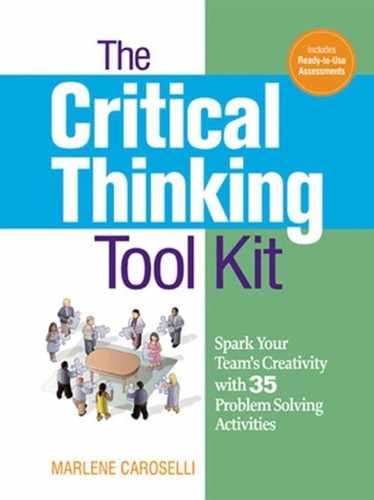#35: Living Problems, Lively Solutions
Overview: |
“Autonomy of object” refers to the problem-solving process of making a problem come alive in order to find a possible solution. Participants will work in small groups to solve a problem of their own choosing in this manner. |
Objective: |
To provide participants with a problem-solving tool. |
Supplies: |
None required |
Time: |
Approximately 15 minutes |
Advance |
Arrange the group, if logistics permit, into subgroups of five members. |
Participants/ |
Because this exercise generates lively discussion, it works well as an ice-breaking activity. Applicable to any size group, it can also be used during the training session or at its conclusion. All that is needed for these last two applications would be a problem that arose naturally during the preceding training. |
Introduction to Concept:
“Autonomy of object” is a technique requiring the problem-solver to actually personify the problem by placing it in the context of a different time or a different place. Interesting and novel solutions to the problem are frequently embedded within the mental associations we normally make with a particular era.
Let us say that graffiti is a problem in a given neighborhood. If the problem were personified, the graffiti might be seen as a bandit in the Wild West era. The Wild West might make you think of a “posse,” and conceivably a posse would be formed to patrol the neighborhood looking for the offenders. This scenario might also make you think of sheriffs. By extension, then, perhaps the police could be asked to patrol more often than they currently do, or could be turned to for advice. Wild West–thinking might also lead you to badges, with their shiny, reflective surfaces. These thoughts could result in an invitation to a chemist to discuss chemicals that might be sprayed on select surfaces to deflect the paint.
Procedure:
1. Begin by listing numerous problems on the board or flipchart. Use problems related to workplace issues, if possible.
2. Prepare a second list, with input from participants, of various eras/locations different from the present. For each era and location, free-associate words related to those times and places.
3. Divide the class into small groups next and ask participants to select a problem and an era or location. They will then devise a possible solution by making the problem come alive (as was done with the graffiti-as-bandit situation).
4. Have the groups share their solutions.
Extending the Activity:
1. Have a current copy of the local newspaper available. Distribute a section or several pages to each group. Ask them to use the autonomy-of-object procedure to make the problem come alive and then to identify a lively solution for the problem.
2. Discuss the simple technique of personification, which makes an inanimate object come alive. Extend the discussion to workplace situations by asking participants to first list issues that concern them, and then to regard those issues from a new perspective by completing one or more of the following prompts:
“If this problem could talk, it would say….”
“If this problem could think, it would realize….”
“If this problem could hear, it would have known….”
“If this problem could create, it would have made….”
“If this problem could be dressed, it would look like….”
Workplace Connections:
1. Ask a group of five supervisors/managers to volunteer to do the following: They will use the autonomy-of-object technique to ameliorate a workplace situation. Then, they will report back to their respective subordinates the success they had with the technique. If it worked well for them, encourage the supervisors to occasionally solve problems this way with their subordinates.
2. A genius has been defined as someone who shoots at something nobody else can see—and hits it. To generate this kind of visionary thinking, ask for a volunteer to call participants at least once during the next six months with this question, “What are you looking at that no one else can see?” To be sure, there are no guarantees that such prodding will result in lively solutions. But it may very well increase the number of invisible targets being hit.
Questions for Further Consideration:
1. The autonomy-of-object technique works because it stimulates thoughts we would not have had without the special context in which we place the problem. What other techniques do you know of to stimulate free association or brainstorming?
